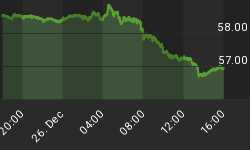Outsized gains were found in silver and gold this week. By most measures the precious metals sector is firing on all cylinders and continues to reflexively bounce from their respective early summer lows. For context, silver has rallied over 24% since finding a low at the end of June. Gold is up over 13%. The gold miners (GDX) have rallied over 37%, tacking on ~ 15% this week alone. Last but not least and widely leading the pack are the silver miners (SIL), which have bounced ~ 50% since finding a low on June 26th.
While surprising as those performance metrics may be, the sector continues to trade close to where we had outlined they would in our note at the end of June: The Case for Buying Precious Metals. Below are few updates from that series.
We've utilized historic momentum breaks and reversals in the financial sector based on two separate time periods - 2009 & 2011.
The long-term ratio chart below illustrates to a degree the correlation behind those two studies and sectors. The value trap series (see Here), with the similar structured banking index BKX (circa 2009 - purple stars) kept us on the right side of the market with its breakdown and currently (chart to the right) in its recovery.
The 2011 comparative (denoted with blue stars above) with the BKX illustrated similar sentiment, market structure and momentum parallels, that to date has resonated in the precious metals sector - specifically their miners. Below is a brief description from our note in June that illustrates the rationale behind this comparative study.
"Back in 2011, a similar market and sentiment environment was spawned in the financial sector as the banks careened lower and tested participants moxie in the shadow of the financial crisis. As we recall, the general sentiment at the time - both within the trading and the pundit class, turned overtly bearish on the banks just as they were completing their cycle lows. The thought of buying Bank of America and Citigroup for anything more than a quick trade was seen as reckless and foolish by analysts and pundits so keen on extrapolating current market conditions forward. From a purely psychological perspective, the retest is often as difficult to navigate and appraise as the initial crisis itself - due to the long tails of the recency effect.
In terms of market structure and momentum, the parallels are evident in the symmetrical and positive divergent nature of their RSI fingerprints and the deeper imprints they recorded versus even during the crisis lows in 2009.
Like the financials in 2011, the more emotionally traded miners have exhibited disproportional losses to their denominating asset class. Our expectations - and similar to the financials circa October 2011, is once the retest is successfully completed, the miners will once again lead the sector higher."
Although the bounce and retracement decline from the 2008 lows were both greater for the gold miners than the banks, the price and momentum structure present a similar behavioral arc: There was a crisis/momentum low that was successfully tested several years later that rejuvenated upside momentum for the sector through attrition.
Below are two additional fractal patterns we had cited for silver and gold.
The 2004 analog that presents the previous cycle in which the Fed pivoted away from peak monetary stimulus continues to prove prescient. This study would roughly target the current rally to continue up to ~ 1475 through mid September, before retracing back to ~ 1300 into October. It has an end of year target of ~ 1600.
Silver firmly turned up another reflationary road this week. We expect inflation expectations to follow.
Rounding things out, the equity markets took the audible corrective path we outlined earlier in the week. Despite shouts from the rafters of an impending crash, we think risk is towards the upside - albeit, likely through a corrective consolidation.
The VIX replicated beautifully with its 2004 comparative outlined earlier in the week.
Audibling somewhat from the 2004 yield study and warranting attention, rates took a turn higher with equity market weakness in the back half of the week. Our concerns are somewhat mitigated by moves in gold and the dollar. We find it noteworthy that yields are roughly where they were at the trough lows in the precious metals sector this summer - while the dollar is currently ~ 4% lower from a high in early July. Our expectations are that yields will catch up with dollar weakness shortly.
Also similar with 2004, we expect emerging markets to continue to outperform the U.S., coming out of their second quarter lows. In the near term this would likely result in a narrower consolidation than domestic equity indexes.
We expect this to translate downstream with a weaker dollar, as illustrated below in the 94' USDX comparative.
* All stock chart data originally sourced and courtesy of www.stockcharts.com
* Subsequent overlays and renderings completed by Market Anthropology
































